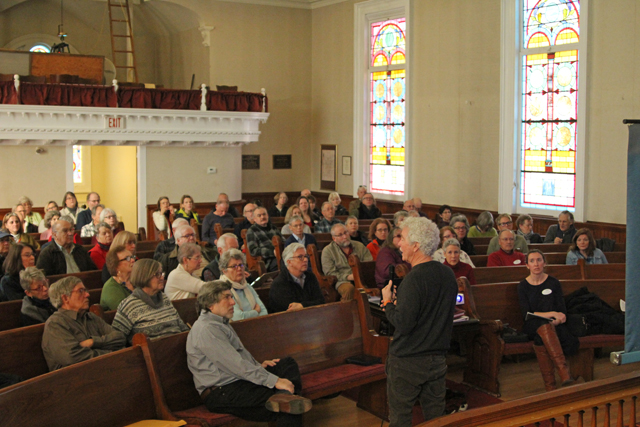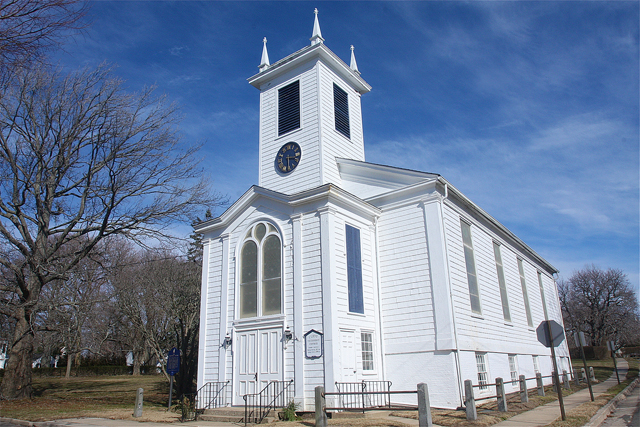Community looks to preserve historic Orient church for public use


It was unusual: The pews at the recently shuttered Orient United Methodist Church were filled this past weekend. Rather than gathering for a sermon, however, locals flocked there Saturday morning to hear from the Oysterponds Historical Society and Orient Association about the building’s future.
Those groups organized the meeting to discuss how the building — which has stood at the corner of Village Lane and Orchard Street since 1836 and is expected to be sold by spring — can be saved from private ownership. The historical society is looking into a public-private partnership to acquire the property so it doesn’t meet the same fate as the former Greenport United Methodist Church, for which housing is currently under review, or Southold United Methodist Church, which was converted last year into the Southold Opera.
“If [preserving the property] is going to happen, it has to happen as a village,” said historical society vice president Ed Caufield.
Last March, 16 members of the dwindling Orient congregation voted to join North Fork United Methodist Church in Cutchogue, which was established in 2014 when the Cutchogue and Southold congregations merged. As of July, that new entity had also absorbed the Greenport and Orient congregations, creating a single regional church. A brand-new house of worship is planned for a site on Route 48 in Southold.
• Related story: What’s next for Orient’s historic Methodist church?
The Rev. Tom MacLeod of North Fork United Methodist Church assured concerned residents Saturday that the church wants to work with the community to keep the Orient property available for public use.
“The merger terms are very important to remember,” the Rev. MacLeod said. “When we merged into the North Fork church we were guaranteeing that the Orient community had a say in the way the building would be sold in the future.”
Locals’ concerns include preserving public access to the church and the adjacent Hallelujah Park — a grassy, shaded parcel that residents have enjoyed for generations — and protecting the historic church pipe organ. Community members also worry about the potential installation of hedges or fencing around the property and fear the church will be converted into housing.
Because the church sits in the Orient Historic District and was landmarked by New York State in 1976, changes to its exterior are subject to many restrictions. There are far fewer limitations on interior alterations.
Ideas suggested Saturday for the building’s future uses included weddings with receptions at nearby Poquatuck Hall, seasonal prayer services and a concert series that would incorporate the pipe organ.
John Holzapfel, former board president of Oysterponds Historical Society, said he believes the church basement could be converted to storage to house the society’s most valuable collections.
The society is currently paying to heat the church to preserve the organ and is researching grant opportunities from the town, county and state, Mr. Caufield said. He added that local elected officials have asked the historical society to gauge community support for preserving the building. To that end, it will conduct a survey to gauge possible financial support for the structure, along with input about volunteerism and future uses.
“Everyone is supportive but not committed,” Mr. Caufield said. “Will the community work with us to save the church for generations to come?”

Orient Association president Bob Hanlon also asked those assembled Saturday if they were willing to take a “leap of faith” in joining the preservation effort, even though a plan for the property hasn’t been finalized.
“This is almost like if you met someone and said, ‘Will you marry me?’ and that person says, ‘Well, on our seventh anniversary what vacation should we take and where will our kids go to school?’” Mr. Hanlon said, eliciting a burst of laughter.
The historical society estimates that the proposed selling price to a community group would be about $950,000, Mr. Caufield said, adding that maintenance costs during the first year of ownership would be at least $50,000 to repair the foundation, gutters, cupola and chimney. Future operation costs are expected to total roughly $20,000 a year, he said.
Suffolk County Legislator Al Krupski, who was represented Saturday by legislative aide Gwynn Schroeder, said in an interview Monday that the church is a “very important parcel on Village Lane and if the county could be of some help there, preserving it as a public space, we’re going to try.”
Mr. Krupski added that the county would require assurances that another agency would maintain the property.
Southold Town Supervisor Scott Russell, who was unable to attend Saturday’s meeting, said Monday that he’s also concerned about long-term management and maintenance of the historic building.
“I know that the historical society is willing to manage it on behalf of the town,” he wrote in an email. “My concern, however, is that, over time, it may be difficult for that group to raise enough money to cover what I am sure will be huge expenses. This is especially true considering the expenses of maintaining the historical assets they already have. The more likely scenario is that, eventually, the town will be expected to cover some or all of those costs.”
Mr. Russell also said he believes the lack of parking at the site makes it unsuitable for public access and expressed concern about the idea of the town supporting preservation efforts when plans for the property’s future remain unclear.
“There may be differing viewpoints of what [public use] means to the community, the historical society and the town,” he said.
As for using money from the town Community Preservation Fund to cover a portion of the property’s purchase price, the supervisor said, “We are already seeing requests to use some of the money for nitrogen reduction systems. Adding historic structures to the mix can really deplete money needed for preservation.
“If we are going to make town acquisition of historic properties one of our tools for preservation, then we should focus on what kind of program do we want rather than making decisions around one specific property,” he continued.
At the start of Saturday’s meeting, former Orient Association president Venetia Hands said she was concerned that adding another event venue to the tiny hamlet could hurt Poquatuck Hall, which regularly hosts concerts and community events. Toward the end of the discussion, however, she announced she had changed her mind and would support preservation efforts after listening to the array of ideas for how the building could be used.
“I’ve gone from ‘supportive but not committed’ to ‘supportive and committed,’” Ms. Hands said to a round of applause.
She added that when she thinks about her community’s accomplishments, she’s reminded of a famous quote from Margaret Mead: “Never doubt that a small group of thoughtful, committed citizens can change the world. Indeed, it’s the only thing that ever has.”
Top photo: Oysterponds Historical Society vice president Ed Caufield gives a presentation Saturday at the former Orient United Methodist Church. The historical society is looking into a public-private partnership to acquire the property for public use. (Credit: Jen Nuzzo)








